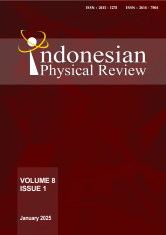SYNTHESIS OF BIOMATERIAL-GRADE WHITLOCKITE FROM CRAB SHELL WASTE: AN ECO-FRIENDLY APPROACH
DOI:
10.29303/ipr.v8i1.403Downloads
Abstract
Crab shells, rich in calcium carbonate (CaCO3), provide a sustainable source of calcium oxide (CaO) for synthesizing Whitlockite (WH, Ca9(MgFe)(PO4)6PO3H), a potential biomaterial for bone replacement. This study addresses prior research gaps by exploring synthesis temperature variations from 700℃ to 1000℃  and employing acid precipitation to yield high-purity WH. Characterization was performed using Fourier Transform Infrared (FT-IR), X-ray Diffraction (XRD), X-ray fluorescence (XRF), Scanning Electron Microscopy (SEM), and Brunauer Emmet-Teller (BET) analysis. Results indicate that the crab shell powder contains 99.0944%wt. The XRD results show that optimal crystallinity and purity of WH were achieved at a calcination temperature of 900℃.  The FTIR test results show that the functional groups of WH at calcination temperatures of 700℃, 800℃, 900℃, and 1000℃ for 5 hours are detected in specific wave ranges, namely PO₄³- (673-671 cm-¹), and OH- (3340-3198 cm-¹), which contribute to the bone formation process. SEM tests revealed that changes in calcination temperature affected the morphology of WH, with the optimal temperature producing a smaller size, minimal agglomeration, and a more uniform size distribution. BET analysis showed that 900℃ gave the highest adsorption capacity and good stability, indicating a more significant potential for interaction with body cells. These findings confirm the ability of WH to be a promising biomaterial for bone replacement applications.
Keywords:
Whitlockite Crab shell Biomaterial BiomedicalReferences
R. Fadli. “Fakta Gizi Kepiting dan 7 Manfaatnya bagi Kesehatan Tubuh.†Halodoc.com. Accessed: Jan. 13, 2024. [Online.] Available: https://www.halodoc.com/artikel/fakta-gizi-kepiting-dan-7-manfaatnya-bagi-kesehatan-tubuh
S. Sadya. “Mayoritas Produksi Kepiting dari Kalimantan pada 2021.†Dataindonesia.id. Accessed: Jan. 13, 2024. [Online.] Available: https://dataindonesia.id/industri-perdagangan/detail/mayoritas-produksi-kepiting-dari-kalimantan-pada-2021
E. Kusumawati, “Evaluasi Nilai Nutrisi Limbah Rajungan dan Kajian Potensi Sebagai Pakan Unggas,†BSVAH. thesis. Dept. Animal Husbandry., Mataram Univ., Mataram, NTB, Indonesia, 2014. [Online]. Available: https://scholar.google.com/scholar?cluster=12815697997545937586&hl=en&oi=scholarr
F. Farikhin, “Analisa Scanning Electron Microscope Komposit Polyester Dengan Filler Karbon Aktif,†scientific publication. Dept. Mech. Eng., Muhammadiyah Surakarta Univ., Surakarta, Central Java, Indonesia, p. 1–16, 2016. [Online]. Available: https://eprints.ums.ac.id/45216/1/NASKAH%20PUBLIKASI.pdf
Subagio. et al., “Pra Perancangan Pabrik Kalsium Karbonat Dari Kalsium Oksida Dengan Proses Karbonasi Kapasitas Produksi 70.000 Ton/Tahun,†scientific publication. Dept. Chem. Eng., National Institute Tech. of Malang, Malang, Central Java, Indonesia, p. 1-2, 2017. [Online]. Available: https://eprints.itn.ac.id/9221/2/1814031_BAB%20I.pdf
A. Afonina. et al., “Synthesis of whitlockite nanopowders with different magnesium content,†in Ceramic International, p. 32127-32128. Nov. 2022. doi: 10.1016/j.ceramint.2022.07.152
J. K. Ku. et al., “The Effect of Whitlockite as an Osteoconductive Synthetic Bone Substitute Material in Animal Bony Defect Model. Materials,†in MDPI Journal, p. 9-10. March. 2022. doi: 10.3390/ma15051921
J. Baek. et al., “Marine Plankton-Derived Whitlockite Powder-Based 3D-Printed Porous Scaffold for Bone Tissue Engineering,†in MDPI Journal, p. 5-10. May. 2022., doi: 10.3390/ma15103413
Y. Z. Jin. et al., “Effect of Whitlockite as a new bone substitute for bone formation in spinal fusion and ectopic ossification animal model,â€in Biomaterials Research, p. 5-6. Oct. 2021., doi: 10.1186/S40824-021-00237-3
A. Awan. et al,. “Whitlockite -A study on the effect of reaction parameters on morphology in a one-solvent system,†in Materials Chemistry and Physics, p. 314. 2024. doi: 10.1016/j.matchemphys.2024.128932
Suyanti & Purwani. “Akselerator KALSINASI KONSENTRAT SERIUM MENJADI SERIUM OKSIDA,†Pusat Sains dan Teknologi, BRIN paper. 2016. [Online]. Available at: https://karya.brin.go.id/id/eprint/2490/1/Makalah%20KTI%20penulis%201.%202.pdf
I. L. Putama Mursal. “Karakterisasi Xrd Dan Sem Pada Material Nanopartikel Serta Peran Material Nanopartikel Dalam Drug Delivery System,†in Pharma Xplore : Jurnal Ilmiah Farmasi, 3(2). p. 214–221. 2018. doi: 10.36805/farmasi.v3i2.491
A. K. Mahera, “Synthesis and structural characterization of hydroxyapatite (Hap) from chicken eggshell for biomaterial applications,†B.S Thesis, Dept. Physics, Kalimantan Institute of Technology, 2024.
A. Kurniawan. et al. “STUDI PENGARUH VARIASI SUHU KALSINASI TERHADAP KEKERASAN BENTUK MORFOLOGI, DAN ANALISIS POROSITAS NANOKOMPOSIT CAO/SiO2 UNTUK APLIKASI BAHAN BIOMATERIAL,†in Jurnal Penelitian Fisika dan Aplikasinya (JPFA), 4(2). p. 22. 2014. doi: 10.26740/jpfa.v4n2.p22-26.
T. O. Pangestu, et al. “Sintesis dan Karakterisasi Kalsium Fosfat dari Cangkang Bekicot dengan Metode Presipitasi,†in CHEESA: Chemical Engineering Research Articles, 4(2). p. 82-90. 2021. doi: https://doi.org/10.25273/cheesa.v4i2.8931.82-90
V. Inna, et al. “Synthesis and Properties of Manganese-Containing Calcium Phosphate Materials,†in Inorganic Materials. p. 704. July. 2020. doi: 10.1134/S0020168520070055
S. Batool, et al. “Synthesis, Characterization and Process Optimization of Bone Whitlockite,†in Nanomaterial Journal, 10(9). p. 3-5. Sep. 2020. doi: https://doi.org/10.3390/nano10091856
R. S. Peixoto, et al. “Synthesis and characterization of Naringin functionalized nano-hydroxyapatite,†in Journal of Pharmacy and Bioallied Sciences, 5(1). p. 79-84. 2013. doi:10.4103/0975-7406.106292
P. Rajula, “Synthesis and characterization of Naringin functionalized nano-hydroxyapatite: The presence of OH- indicates the presence of adsorbed water,†in Journal of Pharmacy and Bioallied Sciences, 15(5). July. 2023. doi: 10.4103/jpbs.jpbs_626_22
K. A. Salami, et al. “Utilization of sawdust as a pore-former in the fabrication of ceramic adsorbents for water purification,†in Journal of the Australian Ceramic Society, 58(4). p. 1297–1309. 2022. doi: https://doi.org/10.1007/s41779-022-00778-3
M. Thommes, et al. “Physisorption of gasses with special reference to the evaluation of surface area and pore size distribution (IUPAC Technical Report),†in Pure Appl. Chem, 87. p. 1051–1069. 2015. doi: https://doi.org/10.1515/pac-2014-1117
R. Foroutan, et al. “Modification of bio-hydroxiapatite generated from waste poultry bone with MgO for purifying methyl violet-laden liquids,†in Environmental Science and Pollution Research, 27(35), p. 44218–44229. 2020. doi: https://doi.org/10.1007/s11356-020-10330-0
F. Arsista. “Influence of implant design and under-preparation of the implant site on implant stability in low-density bone,†in International Journal of Environmental Research and Public Health, 17(12), p. 4436. 2018. doi: https://doi.org/10.3390/ijerph17124436
M. Moritz & M. Geszke-Moritz. “Mesoporous materials as multifunctional tools in biosciences: principles and applications,†in Materials Science and Engineering: Materials for Biological Applications, 49. p. 114–151. 2015. doi: https://doi.org/10.1016/j.msec.2014.12.079
I. A. Spiridon, et al. “Insight into Potential Biomedical Application of Mesoporous Materials,†in Pharmaceutics, 14. p. 2382. 2022. doi: https://doi.org/10.3390/pharmaceutics14112382
A. W. Hussain, et al. “Porous Biphasic Calcium Phosphate for Biomedical Application,†in Journal of Biomimetics, Biomaterials and Biomedical Engineering, p. 101-110. Feb. 2021. doi: 10.4028/WWW.SCIENTIFIC.NET/JBBBE.49.101
L. Pejchalová, et al. “In Vivo Assessment on Freeze-Cast Calcium Phosphate-Based Scaffolds with a Selective Cell/Tissue Ingrowth,†in ACS Applied Materials & Interfaces. p. 58326-58336. Oct. 2024. doi: 10.1021/acsami.4c12715
O. Farobie, et al. “In-depth study of bio-oil and biochar production from macroalgae Sargassum sp. via slow pyrolysis,†in RSC Advances. p. 9567. March. 2022. doi: 10.1039/d2ra00702a
O. Farobie, et al. “Valorization of Rejected Macroalgae Kappaphycopsis cottonii for Bio-Oil and Bio-Char Production via Slow Pyrolysis,†in ACS omega. p. 16665. 2024. doi: 10.1021/acsomega.4c00678
License

This work is licensed under a Creative Commons Attribution-NonCommercial-ShareAlike 4.0 International License.
Authors who publish with Indonesian Physical Review Journal, agree to the following terms:
- Authors retain copyright and grant the journal right of first publication with the work simultaneously licensed under a Creative Commons Attribution-ShareAlike 4.0 International Licence (CC BY SA-4.0). This license allows authors to use all articles, data sets, graphics, and appendices in data mining applications, search engines, web sites, blogs, and other platforms by providing an appropriate reference. The journal allows the author(s) to hold the copyright without restrictions and will retain publishing rights without restrictions.
- Authors are able to enter into separate, additional contractual arrangements for the non-exclusive distribution of the journal's published version of the work (e.g., post it to an institutional repository or publish it in a book), with an acknowledgment of its initial publication in Indonesian Physical Review Journal.
- Authors are permitted and encouraged to post their work online (e.g., in institutional repositories or on their website) prior to and during the submission process, as it can lead to productive exchanges, as well as earlier and greater citation of published work (See The Effect of Open Access).





